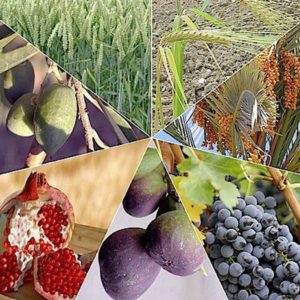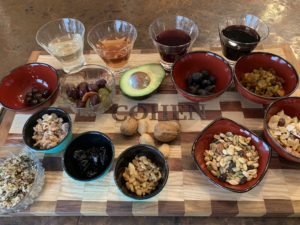Tu B’Shvat Feast Celebrates Israel’s Birthday of Trees
Tu B’Shvat is considered a minor holiday in the Jewish calendar, sandwiched between Hanukkah and Passover, but that doesn’t make this “New Year for the Trees†any less meaningful and fun for your family to celebrate in its fruity, nutty, earthy glory.
 On Tu B’Shvat, which is today the 15th of Shevat, it’s customary to eat fruits from the seven species grown in the Land of Israel: “a land of wheat, barley, [grape] vines, fig trees and pomegranates, a land of olive trees and [date] honey” (Deut. 8:8).
On Tu B’Shvat, which is today the 15th of Shevat, it’s customary to eat fruits from the seven species grown in the Land of Israel: “a land of wheat, barley, [grape] vines, fig trees and pomegranates, a land of olive trees and [date] honey” (Deut. 8:8).
At this feast of fruits and nuts, we also drink four cups of wine (or juice), transitioning from white to red, and this custom represents our flavorful journey to clarity and spiritual fulfillment.  A Kabalistic tradition is to eat and drink plentiful at a seder—much like we do on Passover, only with rituals, prayers, and storytelling that is unique to this special holiday Tu B’Shvat.
The Kabbalsitc rabbis in the 16th century believed that by exploring the intricacies of these fruits and how they relate to our own human characteristics, we will gain greater understanding and appreciation of God’s creations and ultimately a higher level of spiritual awareness.
So, let’s eat! The FIRST FRUIT we nibble on is edible only on the inside (such as walnuts, coconuts and almonds). The hard shell symbolizes the protection that the earth gives us and reminds us to nourish the strength and healing power of our own bodies.
Barukh ata Adonai, Eloheinu Melekh ha-olam, borei peri ha-etz.
Blessed are You, Source of all life, Creator of the fruit of the tree.
The SECOND FRUIT we enjoy is edible only the outside (such as olives, dates, peaches, and apricots). The hard internal seeds reminds us of the spiritual and emotional strength that is within each of us.
 Barukh ata Adonai, Eloheinu Melekh ha-olam, borei peri ha-etz.
Blessed are You, Source of all life, Creator of the fruit of the tree.
The THIRD FRUIT has an edible exterior and interior (figs, grapes, and raisins), symbolizing God’s omnipresence and our own inextricable ties with the earth.
 Barukh ata Adonai, Eloheinu Melekh ha-olam, borei peri ha-etz.
Blessed are You, Source of all life, Creator of the fruit of the tree.
Finally, save room for the FOURTH FRUIT that has a tough skin on the outside and a sweet fruit within (mangos, bananas, avocados, or sabra, a desert pear). These foods represent the mystery of the world and our hunger to study Torah and uncover secrets and wisdom that nourish our souls.
And if that’ not enough on your plate, Tu B’Shvat also invites us to try a “new fruit” – a seasonal delicacy that we haven’t tasted before, meaning we’re never too old to learn something new.
Ba-ruch A-tah A-do-noi E-loi-hei-nu
Me-lech ha-o-lam she-he-chee-ya-nu v’ki-yi-ma-nu
vi-hi-gi-ya-nu liz-man ha-zeh.
Blessed are You, L-rd our G‑d, King of the
Universe, who has granted us life, sustained us and
enabled us to reach this occasion.
And now we drink…
We savor the four glasses of wine in this order: white, white with a little red, white that’s mostly red, and red, symbolizing the changing of the seasons and the cycle of God’s creation.
(1) WHITE WINE symbolizes winter and the mystical dimension of atzilut, or emanation, at which God’s energy infused the creation process with initial life.
Barukh ata Adonai, Eloheinu Melekh ha-olam borei peri ha-gafen.
Blessed are you, Source of all life, Creator of the fruit of the vine.
(2) WHITE WINE WITH A LITTLE RED mixed in symbolize the passing of the seasons and the mystical concept of formation and birth, often associated with water.
Barukh ata Adonai, Eloheinu Melekh ha-olam, borei peri ha-gafen.
Blessed are You, Source of all life, Creator of the fruit of the vine.
(3) MOSTLY RED WITH A LITTLE WHITE MIXED IN symbolizes once again the change of seasons and the mystical concept of beriah, or creation.
Barukh ata Adonai, Eloheinu Melekh ha-olam, borei peri ha-gafen.
Blessed are You, Source of all life, Creator of the fruit of the vine.
(4) RED WINE symbolizes the mystical concept of fire and the idea that within all living things dwells a spark of the Almighty.
To keep it all straight and follow what and when to eat and drink at your seder, download a Hagaddah, such as this one.
https://www.sestl.org/wp-content/uploads/2017/03/Tu-BShevat-Haggadah-by-JEI-STL.pdf
In contemporary Israel and throughout the world, Tu B’Shvat is a sort of Jewish Arbor Day or Earth Day– a time to bring environmental awareness to the forefront and learn how to take better care of our environment for generations to come. Did you know Israel has more than 240 million trees, 150-plus nature reserves and 65 national parks? In fact, Israel is the only country in the world that has more trees today than 100 years ago! Here’s a fun birthday gift– to plant a vine in ISRAEL, go HERE!
“When God created Adam, God took him and showed him all the trees of the Garden of Eden and said to him ‘See My works, how beautiful and praiseworthy they are. And everything that I created, I created it for you. Be careful not to spoil or destroy My world – for if you do, there will be nobody after you to repair it.†Midrash Kohelet Raba
Here’s some recipes to try on Tu B’Shvat, incorporating the seven species native to Israel, such as a spicy cocktail with fig liqueur,  Wake up chocolate fruit kicks, Spring barley risotto and asparagus and lemon,  arugala salad with dates and chevre, and for dessert date fig bars.
Tu B’Shvat is a special holiday that plants the seeds of gratitude, literally, to nourish our souls and teach our children to grow. For more ideas on how and why we celebrate, read HERE.

